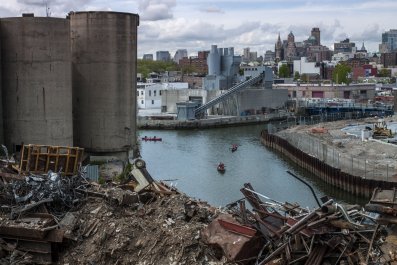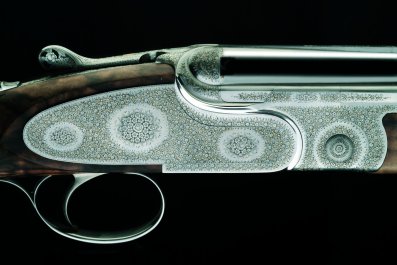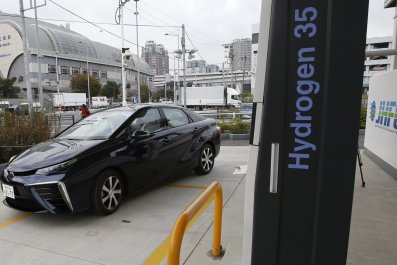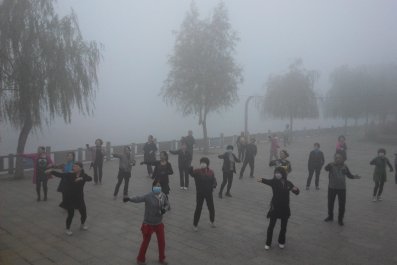The River Spree flows northwest for 250 miles from the Lusatian Mountains, near the Czech border, to central Berlin. From there, at the eastern tip of Spree Island, it splits like a wishbone into two arms and heads west. Tourist boats frequent one arm, which is wider and passes popular destinations like the DDR Museum, which shows what life was like in East Germany under Soviet rule. The other arm, Spree Canal, is narrower and has been largely out of use for more than a century. The area around it is generally residential. And several times a year, to prevent the sewers from flooding during heavy rain, pipes redirect untreated sewage into the canal.
Tim and Jan Elder, brothers who grew up in West Germany, envision turning that polluted spot where the Spree splits into the starting point for what they are calling the "Flussbad Berlin": a mile-long system of plants and pipes that would filter the water and convert a stretch of the canal into a giant swimming pool. The Flussbad project (the word means "river pool") sounds ambitious, even quixotic, but last year the German government granted the brothers $4.8 million to test their filter.
On a rainy day in November, the Elders meet at a small pedestrian bridge near the river's fork. A horde of teens have just vacated the spot, leaving behind a half-dozen coffee cups. Below the bridge is the Historic Harbor, where antique boats with names like Elisabeth, Libelle and Andreas bob in the canal, peppered with fallen yellow leaves. Tim and Jan are both wearing blue jeans and identical navy raincoats, which Jan insists he bought first. Call it the uniform of Realities:United, the art, architecture and technology studio they run.
Tim says the idea for Flussbad came in 1997, when he and Jan worked near the Spree. They built a riverside discotheque and man-made beach; The New York Times said the makeshift club had "a jagged energy, an edginess, an openness that leave[s] a piece of formerly eastern riverside property in the hands of an association of artists." The author also mentioned seeing "several young men urinate into the dark water."
"We experienced how super attractive people found [it] to be with the river," Tim says of that venture. That got them imagining how the forgotten waterway slicing through Berlin might become a recreational Eden at a time when the city was becoming congested and more built up. The Elders wanted to give people a way to jump in the river, but many of those people told them the idea was "sufficiently unrealistic" and "totally nuts."
In the almost two decades since, cities around the world have embraced their waterways and postindustrial spaces, part of a global push for sustainable development. "What you see in the Flussbad project is echoed in projects worldwide: a focused intervention that respects that which has been created by previous generations, benefits from natural mechanisms and reinvigorates open spaces for public use," says Rolf Soiron, chairman of the board of the LafargeHolcim Foundation for Sustainable Construction. In 2011 and 2012, LafargeHolcim gave the Elders $150,000 for Flussbad.
"When we invented it, we didn't see anything that was close," Tim says. Now, Jan adds, "everybody wants to be at the river." In New York City, for example, + Pool aims to be "the world's first water-filtering floating pool," the project designers have said, with special walls that filter water from the East River. (It remains in development.) Swimmers have taken to rivers in cities around the world—even in Basel, Switzerland, where the 1986 Sandoz chemical spill once poisoned the waterway. But Jan says, referring to Flussbad, "As far as I understand, it's the only project which at that scale really changes the river itself."
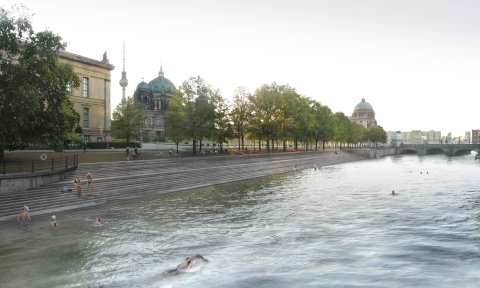
Industrial mills used to occupy both sides of Spree Canal, which was a popular shipping lane until 1894, when the city demolished some of the mills and built a lock in the main arm of the river, making it easier for ships to use that route. Decades later, the city demolished a separate lock on the canal, the Elders say, making it nearly impossible to traverse. Since then, the canal has sat mostly unused, still apparently costing Berlin millions of dollars a year to maintain. Though the Spree appears black from afar, when you look down at it close up, it's possible to see to its bottom. But because of the sewage system that dumps human waste into the canal without warning, swimmers risk nausea, vomiting and diarrhea.
In November, the Elders published a 99-page feasibility study on how to make the Spree safely swimmable. Flussbad will consist of three sections: a natural zone that would attract fish and wildlife and have recreational spaces; a filtration zone; and a 2,788-foot-long swimming zone through one of the city's most tourist-heavy areas. At the end of the stretch, a weir would keep the unfiltered water from flowing back into the swimming pool.
The most important piece of that puzzle is the plant-and-sand filtration system the brothers have devised (with the help of some engineers). They'll start by digging holes in the river bottom and filling them with permeable sand. As water passes through the sand, a microchemical process cleans it. Planted reeds help keep the sand in place. It's an open system that continually takes in water, cleans it and releases it. Typical filtration systems function more like giant coffee filters, but they need periodic cleaning or replacing; this innovative plant-and-sand filter is all natural and requires no energy. Pollutants get "digested" by what Tim describes as "a film of microlife" around the sand, including bacteria. The system would be able to filter 132 gallons per second.
The process may sound simple, but it requires more than digging holes and planting reeds. Because the Spree tends to flood, Flussbad must also incorporate a complex system of pipes that can allow river water to bypass the filter (and temporarily put swimming on hold). And unless the city updates its sewer system, the project must also implement a drainage system to redirect sewage that would otherwise flow into the canal. It's not just "making a garden in the river," Tim says.
Above the filtration zone would be a "natural" zone, which could attract insects like dragonflies and fish such as eel, ide, perch, pike, rudd and silver bream, according to the feasibility study. Currently, Jan says, "wildlife has basically no chance" there. Along the route would be low-lying artificial jetties, lookout spots and bicycle paths.
From the filtration zone, the water would flow into a swimming area the length of 17 Olympic-size pools. That section would have big stairways to access the water from the street level, as well as possibly dressing rooms, showers and lockers. The system would flush out the pool water once a day to prevent the formation of blue-green algae, bacteria that can release toxins. This zone would span from the Schlossplatz (where the Humboldt Forum, a re-creation of a 500-year-old Baroque palace that the German Democratic Republic demolished in 1950, is under construction) to the Bode Museum. For more than half a million Berliners, Flussbad would be the closest natural body of water in which to swim, according to the project's website.
So far, Flussbad has been funded by prize money, grants and individual donations. The Elders won't disclose how much the project will cost—their current estimate could dissuade politicians from supporting the project, they say—but they hope the government will foot most of the bill.
Having figured out the science and (most of) the financing, the brothers now face their last obstacle: Berlin bureaucracy. Altering major city infrastructure will require wading through lots of red tape, especially since the canal passes Museum Island, which is part of Spree Island and is a UNESCO World Heritage Site. Critics have already bashed the plan to cut stairways into the canal walls, portions of which date back to the 19th century and were designed by famed Prussian architect Karl Friedrich Schinkel.
In public discussions, Tim and Jan have observed that younger Berliners seem more open to the project than the city's older citizens, seeing it as "a substantial aspect of future life," Tim says. Older people, on the other hand, seem to have a harder time understanding "that this is not just a fun-and-nuts thing."
In July, the Elders hosted a swimming competition in the still-unfiltered Spree to draw attention to their project. Around 120 swimmers, wearing yellow bathing caps, jumped into the black water. Tim and Jan each took a dip but spent most of the day watching from the sideline, towels in hand. They both concede they cannot swim.







